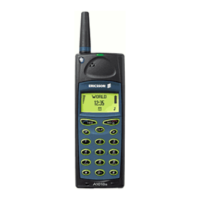A1018s/A1018sc Standard Electrical Repair
4/00021-2/FEA 209 544/16.B 16 (42)
If both resistances are correct, measure the resistance between P800 (fig. 4.1) and
N800:14 (fig. 4.2) (~2 kOhm).
• If it is too large, is there a foil damage and the board has to be discarded.
Measure the resistance between P801 (fig. 4.1) and ground (1.5 kOhm).
• If the resistance is too low, replace C820 (class A, fig. 4.2).
• If the resistance is too large, replace R820 (1.5 kOhm, class A, fig. 4.2).
If the fault still remains, send the phone to the next repair level.
4.4 Both the earphone and the microphone are
out of order.
Open the phone and check for liquid damages.
Check the soldering at N800 (Note! Class C) and D600 (fig. 4.2)
Give the board power and start it using the On/Off button.
Measure the voltage VDIG at N701:5 (~3.2 V, fig. 4.2).
• Incorrect: Proceed to chapter 3 (“Doesn´t start”-fault).
Measure the voltage (~3.2 V) at both sides of R601 (fig. 4.1) and at D600:70 (fig.
4.2).
Measure the voltage (~3.2 V) at both sides of R605 (fig. 4.1) and at D600:67.
• If the voltage at R601 or R605 (both class A) is too low at only one side, replace
the resistor.
* If that doesn´t make it, replace D600.
• If the voltage is too low at both sides of R601 or R605, measure the voltage at
R635 and R636 (~3.2 V, class A, fig. 4.1).
* If a resistor is incorrect, replace it. If VDIG (~3.2 V) is missing at R635 and
R636, but exists at N701:5, the board has got a foil damage and has to be dis-
carded.
If the fault still remains, send the phone to the next repair level.

